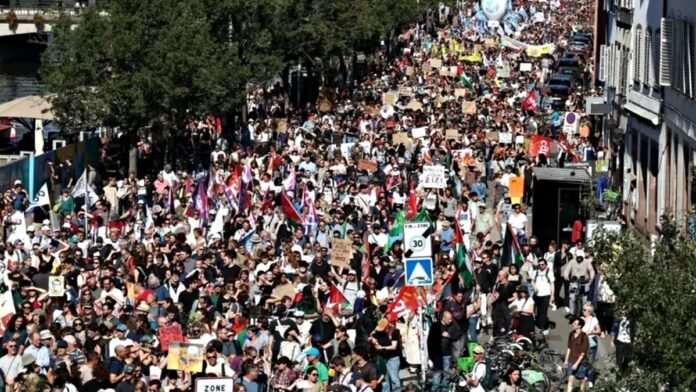
Key Points
- Hundreds of thousands of people protested across France on Thursday, September 18, against proposed government austerity measures.
- Estimates of the crowd size range from 500,000 (Interior Ministry) to over 1 million (CGT union), with 80,000 police deployed.
- The protests turned violent in Paris, Lyon, and Nantes, with police using tear gas against demonstrators who threw projectiles.
- The strikes were called by eight major unions in response to a proposed $52 billion budget cut for 2026, targeting pensions and public services.
- The unrest comes just a week after the previous government collapsed over the same budget plan, putting immense pressure on President Macron and his new Prime Minister, Sébastien Lecornu.
Peris: France was gripped by massive nationwide strikes and protests on Thursday as hundreds of thousands of people took to the streets to oppose the government’s planned austerity measures. The demonstrations, which involved teachers, transport workers, pharmacists, and students, led to widespread disruption and violent clashes with police in several major cities.
The scale of the mobilization was immense. While the French Interior Ministry estimated that around 500,000 people participated, the CGT trade union claimed the number was over one million. In response, the government deployed 80,000 police officers and gendarmes. The protests paralyzed public transport in Paris, shut down schools and an estimated 98% of pharmacies, and saw students blocking highways and university entrances.
In France, more than 1 million people took to the streets as part of the"Block everything" protest
— Chay Bowes (@BowesChay) September 18, 2025
300 people were arrested
Teachers, train drivers, pharmacists, and medics declared a strike
Here Police in "Free Europe" kick a young woman along the street. pic.twitter.com/zWi8sM6VYj
Clashes and Political Crisis
While the protests were largely peaceful, tensions boiled over in Paris, Lyon, and Nantes. In Paris, a small group of black-clad demonstrators hurled rocks and bottles at riot police, who responded with tear gas to disperse the crowd near the Place de la Nation.
The day of action is a direct challenge to President Emmanuel Macron and his new Prime Minister, Sébastien Lecornu, who was appointed just last week after his predecessor’s government collapsed over the very same budget dispute. The protests are seen as a “warning shot” to the new administration.
The Dispute Over Austerity
The anger is fueled by a proposed €44 billion ($52 billion) budget cut for 2026. The plan, introduced by the previous government to tackle France’s soaring debt and deficit, included freezing pensions, increasing healthcare costs, and reducing spending on public services like education.
Unions and protesters have slammed the measures as “brutal” and “unjust,” arguing they force workers, retirees, and the unemployed to shoulder the burden while the wealthy are protected. They are demanding the cuts be abandoned and are instead calling for higher taxes on corporations and the rich. Many protesters are also voicing continued anger over Macron’s unpopular 2023 pension reforms, which raised the retirement age from 62 to 64. In a minor concession, the new prime minister has already dropped the controversial proposal to eliminate two public holidays.



















































